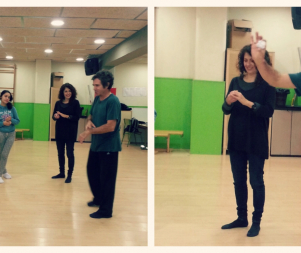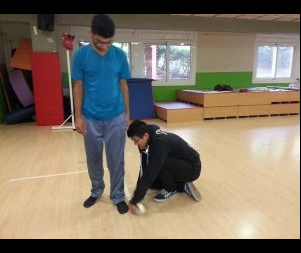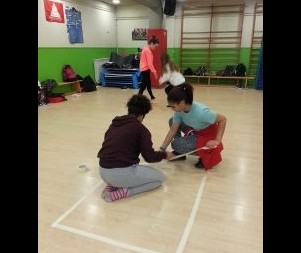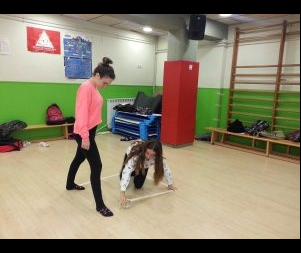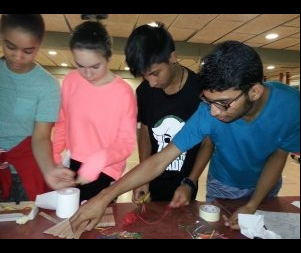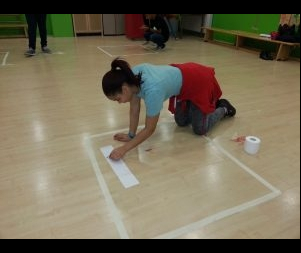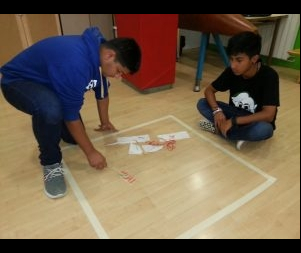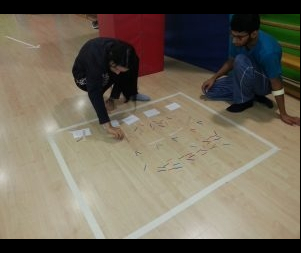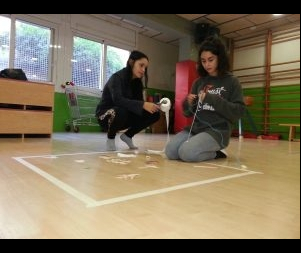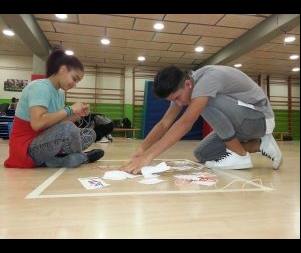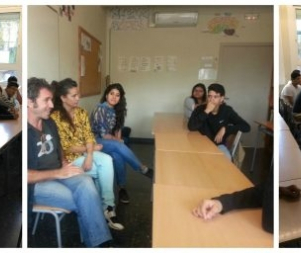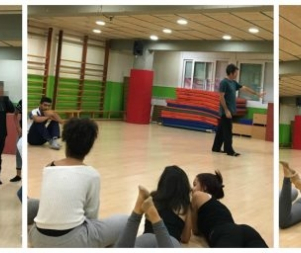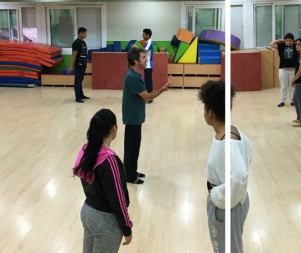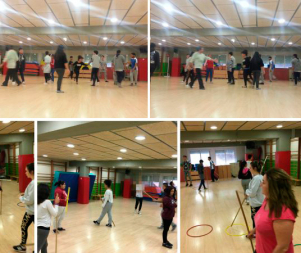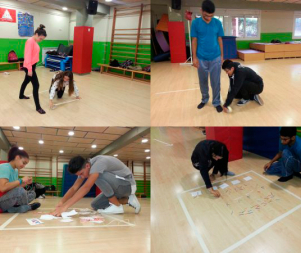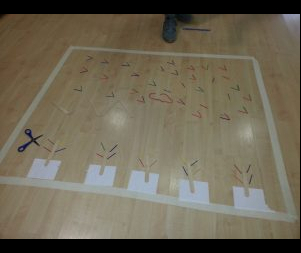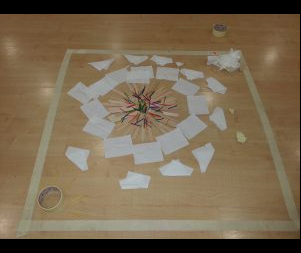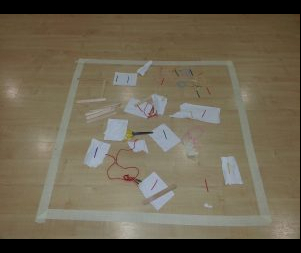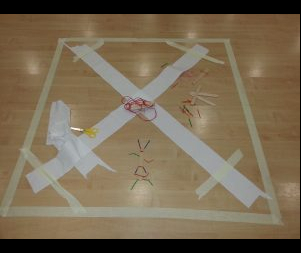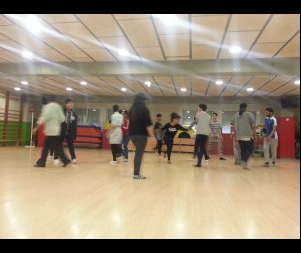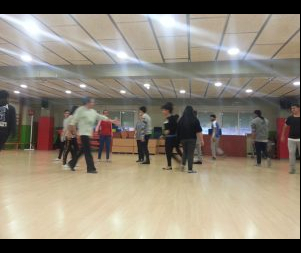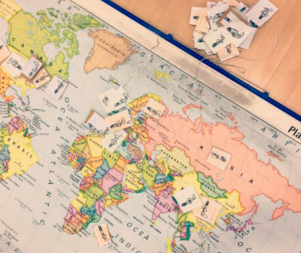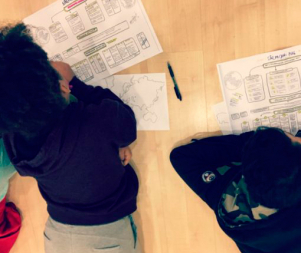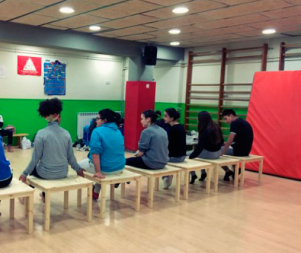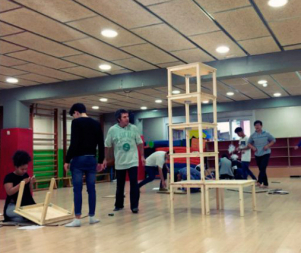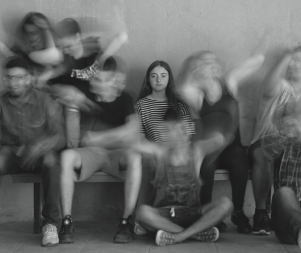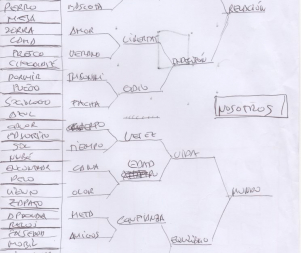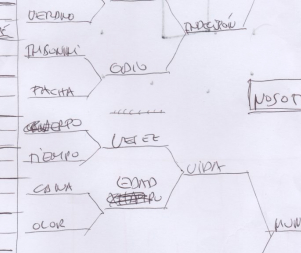- 14th EDITION 2022 / 2023
- 13th EDITION 2021 / 2022
- 12th EDITION 2020 / 2021
- 11th EDITION 2019 / 2020
- 10th EDITION 2018 / 2019
- 9th EDITION 2017 / 2018
- 8th EDITION 2016 / 2017
- 7th EDITION 2015 / 2016
- 6th EDITION 2014 / 2015
- 5th EDITION 2013 / 2014
- 4th EDITION 2012 / 2013
- 3rd EDITION 2011 / 2012
- 2nd EDITION 2010 / 2011
- 1st EDITION 2009 / 2010
Toni Mira IN RESiDENCE at the School Josep Comas i Solà
INTRODUCTION - LET’S BEGIN!
PRESENTATION
After the more performative and site-specific experience of the previous year, in cooperation with Societat Doctor Alonso, and after discussions with the entire team involved in curating the project, it was decided to make the language of movement the absolute protagonist at this eighth edition.
As a result, physical exercises, the dynamics of movement, thinking about what we do and how we do it… Dance in its entirety entered the classroom and found its place, accompanied by other experiences, such as the visit by Alicia Laguna, who works in the field of documentary theatre, for instance. Alicia opened up different views of the performing arts, memory and work through the self, perspectives that are also reflected in the final work, presented by the pupils at the Mercat de les Flors theatre.
Taking into account the thoughts and words that the pupils verbalised after the presentation (cooperation, teamwork, friendship, hard work, freedom and so on), we need to focus on the fact that the preparation itself was a tour de force that unified the group and became a benchmark for the group’s efforts and teamwork.
Toni Mira worked on key points of development in the field of movement (balance, coordination, rhythm, self-awareness of the body, weight and counterweight, disinhibition and so on) while also focusing intensely on teamwork, collective creativity (a good example is the poetic game described in diary blog entries on how they chose the name of the piece, and which you will find later).
DIARY, EXPERIENCES, WITNESS. THE PROCESS
Taking into account that the blog that the pupils, the teacher and the tutor kept on the process provides information about what the project really is, about how it advanced and its final presentation (with collective preparation and the technical residency), we consider it appropriate to transcribe below summaries of the sessions by the pupils and the material worked on at each, and finally reflected in Nosotros (Us).
LET’S BEGIN!
Although the pupils in the third- and fourth-year of ESO compulsory secondary education at Institut Josep Comas i Solà had met Toni Mira, on October 5, it was today that they literally began to move with this artist, who will accompany them throughout the academic year.
The first session with the choreographer began at 8.30 in the morning, when our bodies were still sleepy.
“Let’s walk through the space in time”, Toni Mira
We look each other in the eye, we watch how the other walks, and begin to break the imaginary limitations of the space that exists between the twenty bodies that roam the room. Once we become accustomed to occupying empty spaces, playing with direction and attracting the attention of our classmates, we begin to orbit around those we encounter, while still not entering into contact with them. We play with the dynamics, with rhythm and height, while all the time attempting to follow the rhythm laid down by Ketama and which Toni wants us to interiorise.
It seems that it is hard for us to keep up with the rhythm, but it's only a matter of concentrating and staying calm (Toni's energy seems to spread quickly...). Let's sort this out! The class turns 180 degrees when Toni instructs us to stay still and concentrate on our awareness of our breathing and our bodies. He names our bones from top to bottom, a very simple way of encouraging us to focus on the areas he mentions. We imagine ourselves as “skeletons that air passes through”. At the end of this “tour”, we open our eyes and start walking again. Wow! This is something else...
We now raise our awareness of our bodies through a series of exercises that Toni suggests, and begin to move freely, initiating movement from areas that the choreographer indicates vocally. Once our whole body is twisting along the floor, Toni gives us another instruction: we make this movement on a scale of intensity from 1 to 10, in this way becoming aware of how far we can reach and learning to contain ourselves in order to give what is right and necessary on each occasion.
As a result, a class in which we were supposed to move together, in unison, becomes and uncontrolled mass of movements: some shyer, others more disinhibited, some absurd, others more fluid, but all valid.
The time has come to enter into real contact with the other. Face to face. And there is no other option… We are playing the mirror game. Everything seems fine at first, but things become more complex with Toni tells us it is time to play with cross symmetries, imagining that there is an axis in the centre of the space that separates the members of each pair. When we start to become aware of our laterality and how it is easier to enter into contact with the other in this way, he suggests the “kit” for today’s session:
“Now, in pairs, we will create an eight-movement sequence with whatever symmetry you like.”
Although our discussion has gone on for more than an hour, it is time to give in, to negotiate, to take the physical decision as to what is the sequence we want to show our classmates later. The music changes completely: now it is faster, its rhythms stronger.
We make a semicircle and the pairs try to move, in their sequences, to the rhythm of music. "That’s so fast!" Says a female voice in the class... The more confident and those who understand music best repeat their sequences, attempting to link it to up to three consecutive musical phrases. If the rhythm does not stop... why should we?
"It is also important to know how to stay still," Marian Rivero (teacher of body expression who guides the pupils during the third hour of the project).
Now we are more confident about Toni, in ourselves and in the language and our own bodies, we make a final exercise of weights and counterweights by compression and traction.
Where is our axis? Our point of balance? How much weight can I and should I allow so as to stay upright and not make my partner fall over? Our bodies understand each other better now, and we can leave them over others, come into complete contact and generate a dialogue that is much more deeply engaged.
Finally, we form a circle and gradually move in towards each other, throwing everything we want to get rid of with the loudest shout our anatomy allows us.
Homework for next time: “Brings songs that you really like”, Toni Mira
Wouldn’t it be great if all homework was that much fun? For the third hour, Marian Rivero introduces the theme of “Let’s move as we wish”. At first, we talked about the session with Toni, going over what we did, what was easiest, most fun or most boring. When you are working with a small group with a high level of trust, as is the case here, it is much easier to work with this type of guidelines and exercises. We all realised that it was easier than we thought it would be to work with bodies initially unknown.
“The truth is, it was easy. We are very confident”, Asley Rosado (pupil in the fourth year of ESO compulsory secondary education). As we were already disinhibited from the morning, nothing can stop us. With circles, with sticks, in pairs, in groups, alone, with reggaeton, with ballads... It doesn’t matter; we move with the sole purpose of moving and linking what we dance to the feelings that the songs Marian plays awaken in us. What will she suggest for the next session?
What a coincidence! He wants us to bring songs that we like to the next session, songs that get us moving, that wake us open, songs we can’t stop dancing to when we hear them. So, let’s find music, dance… see you next week!
COLLECTIVE CREATIVITY
Cristina Alonso proposes an activity of collective creativity. We arrange a circuit of squares. In each square is a host, and the guests have to visit all the squares. The hosts take material and begin to work on their squares. The guests look at what their hosts have done, take materials and make alterations… then, all change! The guests visit another square, and so on, so that hosts and guests interact in all the squares. Finally: the collective creations.
How did we feel? Did we feel comfortable with all the guests? Alam felt under attack from one guest, as he didn’t want them to change his work. Othman felt that he was the owner, and wanted to do it alone at first. It seems that all the hosts finally agree that the guests are more in charge than they are, because the guests bring new material for the work.
WHAT IS THE KEY?
“It was interesting to see that we have more self-confidence” (Ashley). “Relaxed” (Alba). ”Fun” (Nathali). ”We coordinate better” (Brahiam). “Fluidity and hard work, the desire to do a good job” (Lucía). “Fun, motivation, group work” (Khalid). “Cool” (Hong). ”Teamwork” (Saad). “Fun, confidence” (César).
WEAVE, WEAVE AND WEAVE... ALICIA LAGUNA (SÂLMON< FESTIVAL) VISITS US
After more than two months with Toni Mira at Institut Josep Comas i Solà, everything starts to come together and take shape. Apart the process of developing the final work, which the open classroom group will create in cooperation with the choreographer, it is clear that Toni has been able to guide the pupils through a work involving relations, the collective and significance.
Gesture, the ability to give meaning to something that we express through our bodies and even the ability to remove all the excess layers of awareness that we place over our movement, are elements that are noted fluidly in the classroom.
Toni Mira has not been alone in this process; taking advantage of the circumstances that have occurred to date during his residency at this second school, he has encouraged plural, transversal, kaleidoscopic work. Apart from the magnificent work that Toni himself is doing, and with a view to establishing relations and building up a broader view of young people, we included a couple of sessions aimed at spreading and diversifying the project.
Firstly, taking inspiration from Toni’s visit to Mexico, Cristina Alonso, who coordinates projects at El Graner, led a session devoted to identity, origin and collective creativity. We talked about where we come from, where are parents are from and where we would like to live, as three simple starting points for thought and the creation of a large visual map of possibilities. Cristina also introduced the class to the Sâlmon Festival, opening up the possibility of one of the Latin American artists taking part in the event might present a session specifically for them.
Connecting with pupils at first-hand, learning about their interests, their background, their way of creating a delimited space and entering into a dialogue with their classmates and teachers; this enables closer bonds to be established, and these also strengthen group work. Not only that, but this approach also encourages the generation of ideas, the search for and inclusion of resources and communication among all participants.
Alicia Laguna, the Mexican artist unanimously selected in the session with Cristina, presents her second special session. Alicia shares this hour with Toni Mira to discuss her projects at the Teatro Línea de Sombra, especially in the work Amarillo. The pupils pay full attention to the screen and to Alicia throughout the class. Migration, the key theme at the session, a theme close to the hearts of most pupils here, and ¡ Alicia’s friendly manner help to generate enormous interest among the whole group.
Toni, who had worked with one of his best-known choreographies at the previous session with the boys and girls from the open classroom, quickly sees the relationship that all this has with his own work. This helps him to broaden his horizons on what to do in future with the pupils, and the path that can best generate interest and encourage personal growth and connection to the piece. Migration? Will we continue to talk and weave ideas together at the other sessions? Perhaps we now have the theme for the piece that they are going to create ... What we do know, for sure, is that we continue!
WE HAVE A TITLE!
The pupils in the open classroom at Institut Josep Comas i Solà have a date, a venue and a name for the show they are creating under the direction of Toni Mira. The work develops exponentially, and there is just a month to go before the presentation in the Pina Bausch room at the Mercat de les Flors at 12 noon on June 16.
Throughout the process, the choreographer has been thinking about what title to put on a piece that is still under construction, and has found a participatory and poetic way of finding a name based on a game he discovered as a teenager.
The game is as follows: together, the group proposes a total of thirty-two arbitrary words, which are written on paper. They are grouped in twos in the order that they are proposed and a word that links both concepts is found, resulting in sixteen new words.
These concepts are paired once more, and the pupils propose eight more words as the possible intersection between the two previous words. The process is repeated until just one word pair is left. The conclusion is that this last word is what is worrying the player.
The group plays the game, and the final pair turns out to be “relation-world”. Do you want to know the word generated by this pair and, therefore, the title of the show?
NOSOTROS [US]
Carry on!
COMPLEMENTARY TEXTS
“Physicality is filled with emotion”, Marisol Rufo
Toni Mira, a well-known choreographer and director of the Nats Nus Dansa dance company, has already crossed the half-way mark of his residence at Institut Josep Comas i Solà. After five months of experimentation and creation in a flexible environment of proximity that encourages group cohesion and artistic creativity, Toni begins to shape the piece that the pupils in the open classroom in the third and fourth years of ESO compulsory secondary education at the school will stage at the end of the course.
In Residence is a transversal project that attempts to respond to the multiple needs of schools and young people, helping them to discover art, in all its genres, as a direct form of encouraging growth and development. That is why the project is conceived as a “contaminant” and is not intended to remain in the classroom, but rather attempts to reach beyond both classroom and school. The goal is to reach out to other pupils in the neighbourhood, to create community, arouse interest and, also, attract audiences.
Toni understands the process as a collaborative, synergetic exercise to which everything and everyone adds something. His knowledge of architecture and love of this art revolve around form, geometry, the visual, mapping… That is why the process is developed “diagonally”, with the support of other teachers and subjects, such as mathematics and art. Dance is a code that permits a great deal of license, and Toni works on the piece like a fragmented whole that passes through different states, and like a construction of different spaces that taken on different meaning. Sometimes with great force, at others for the pleasure of doing and looking.
“I work through form. That is how we can generate all the content we want”, Toni Mira
Moreover, the particular nature of the residency at this school, apart from any specific artistic discipline – which changes every year – is that it is in an open classroom and has a practical focus. The pupils have the chance to work as interns at companies in different professional sectors. This residency aims to truly open up sectors and to make the performing arts, in all their processes and professions, an option for these young people.
Opening up possibilities is always opening up the future. The group attended sessions like that presented by the artist Alicia Laguna, artistic director at the Teatro Línea de Sombra in Mexico, and the visit to the Mercat de les Flors theatre to see Pere Faura’s latest piece, Sweet Tyranny. These sessions also enabled the pupils to learn about other ways of working and to discover other spaces and other artists.
Similarly, the choreographer tries to ensure that the content generated in the piece is of interest to them, and that is why he wanted to know what they hate and what they like about their environment. In short, dance is a form of personal self-expression and is always more interesting when we speak about what really concerns us and want to communicate to others.
“Physicality is filled with emotion”, Toni Mira
Toni’s approachability and composure created a lot of interest among the pupils, showing that art generates links, changes and, above all, develops emotion, understanding and affection among people.
“The gym door is filled with interested people. There are always eyes watching”, Toni Mira
It is remarkable and a good indicator of the project’s success that two young people from the group decided to take part in a show that Toni is preparing for the Altre Festival, a festival of performing arts and mental health. Ashley Rosat and Alam Carrera go to all the rehearsals that the choreographer leads at Fabra i Coats and the Baró de Viver Community Centre to prepare this piece.
Art transforms and opens up paths. Work focuses actively on ensuring that the generation of relationships is expansive and collaboration is shared by the maximum possible number of agents. Generating shared readings and links between them is always enriching.
KEY EXPERIENCES
We should like to note particularly three moments at the 2016-2017 academic year In Residence project at IES Josep Comas i Solà:
Participation in Grada Jove, an initiative aimed at young people at the Mercat de les Flors theatre
The group of pupils involved in In Residence this year took part in Grada Jove, a programme for young people including fun, hands-on sessions for working and rehearsing, understanding and discovering the process of composing a dance show. Different formats aimed at breaking down barriers and establishing dialogues through the show, between the artist and the spectator. Aimed at enabling young pupils in the upper cycle of primary education, secondary and baccalaureate and vocational training to enjoy the shows involved.
On this occasion, the show that opened the Grada Jove programme was Sweet Tyranny by the choreographer Pere Faura. This was a great experience, because they saw a show before its premiere, with the proximity of the creative process, the choreographer and the team, in a process like In Residence, where the pupils at IES Josep Comas i Solà secondary school were just beginning to include dance in their day to day life. What is more, Pere Faura’s show uses a young, pop iconography and is a direct meditation on work and leisure, subjects close to the hearts of pupils, who have opinions about them.
Two pupils perform in a piece by Toni Mira
Two pupils from the Josep Comas i Solà school accompanied Toni Mira in a most unusual project: a piece for the Altre Festival of performing arts and mental health. For the 2017 edition of this festival, Toni created a piece for eight people of different ages and background, and this was presented at Fabra i Coats. A one-off experience that further consolidated Toni's work with the In Residence group and enriched both the choreographer and the participating pupils.
Technical residency at the Sala Pina Bausch
Two and a half days before the presentation (June 14-15-16), the pupils took part in a technical residency in the room where they made the presentation, the Sala Pina Bausch at the Mercat de les Flors theatre. The technical residency is important, because it tests the mechanisms of patience, effort and collective work to the limit and enables the pupils to learn about the more technical part of what, until now, 100% about creativity, and to come into contact with the professional art world.

